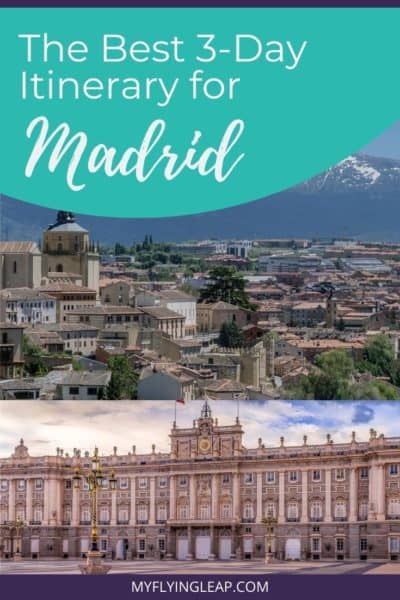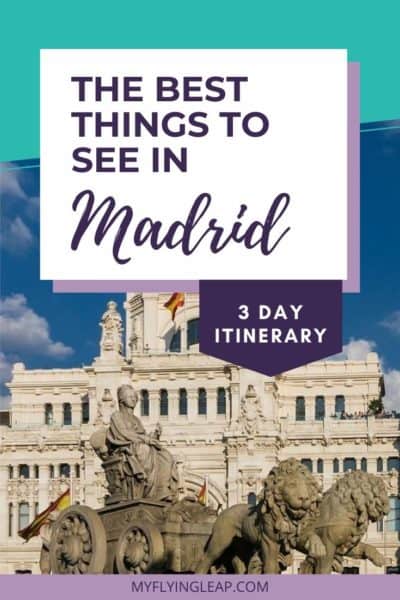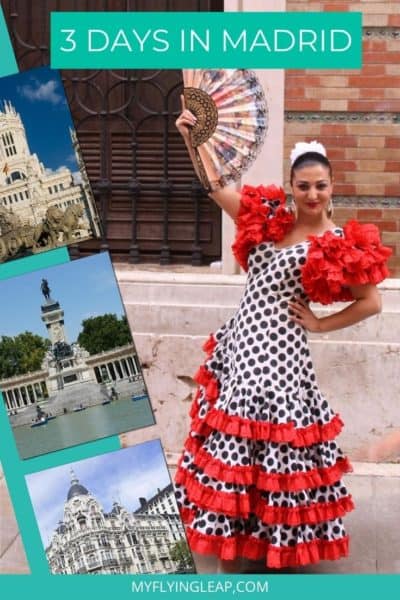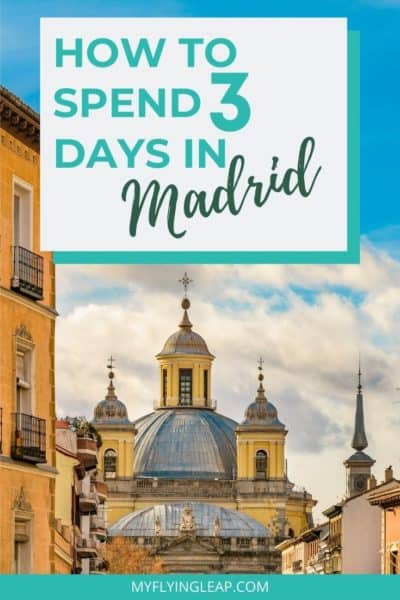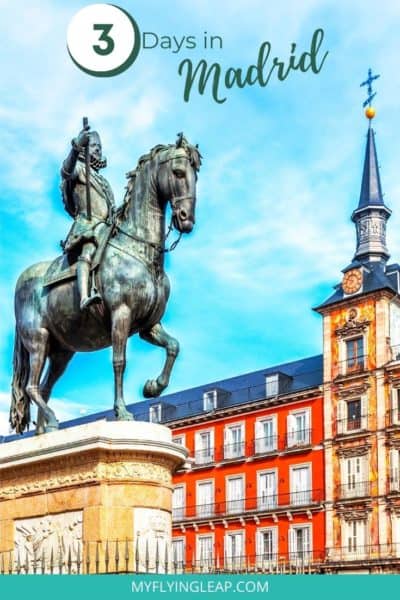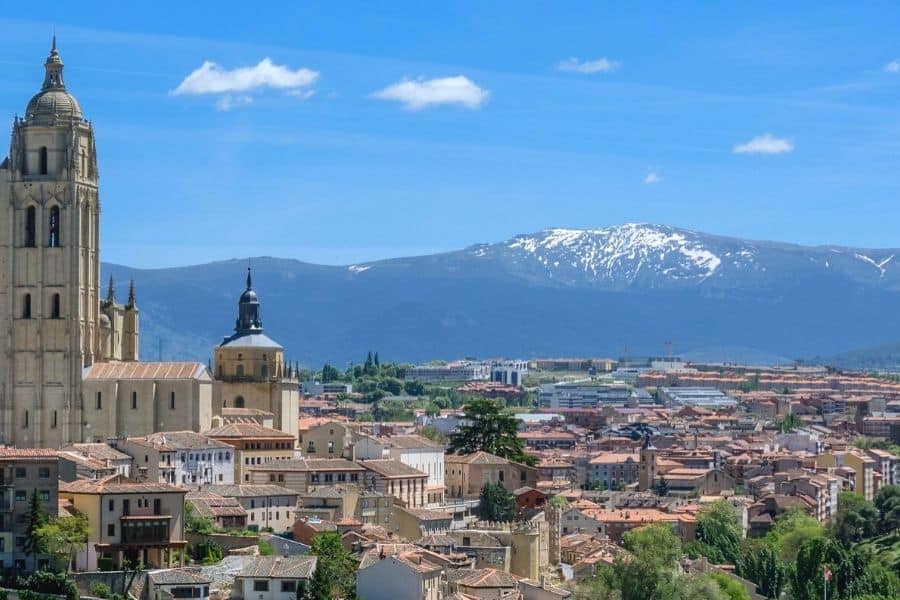3 Days in Madrid: The Best Things to See and Do
Planning a trip for 3 days in Madrid and looking for the top things to see and do? If so, you’re in luck! This post will provide all you need to know to book your trip.
Madrid or Barcelona? That was my debate the first time I went to Spain. Tough choice, right? Both are incredible European cities with a lot to offer visitors.
I chose Madrid for its proximity to Córdoba and Seville. Those cities are incredible, but so is Madrid! The capital city has so much to see and do and really should not be missed when you visit Spain. There is a lot to see and do in Madrid.
3 days in Madrid isn’t nearly enough, but here is how to make the most of it.
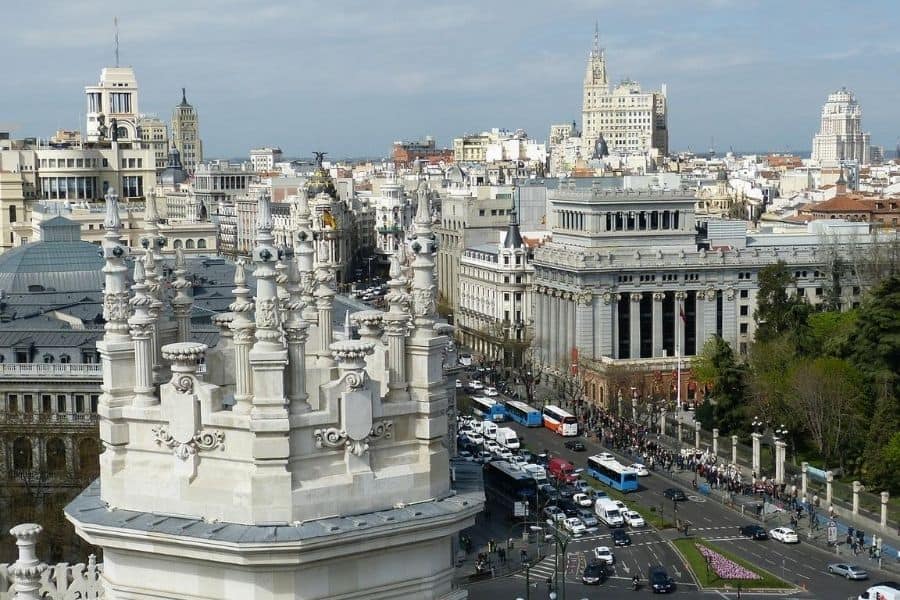
This post may contain affiliate links, which means I’ll receive a commission if you purchase through my links at no extra cost to you. Please read the full disclosure for more information.
How to Spend 3 Days in Madrid—Quick List
There’s a lot to pack into a trip to visit this city and 3 days in Madrid is hardly enough. However, if that’s the time you have, you can absolutely make the most of it and maximize your visit. Here’s how.
Day 1:
Day 2:
- Visit the Royal Palace
- Stroll around El Retiro Park
- Siesta (you’ll need it!)
- Flamenco
Day 3:
Each of your 3 days in Madrid covers the highlights of Madrid and allows for some free time for you to add in things that you see and are interested in. What would an itinerary be without hitting the best places to visit in Madrid?
I learned my lesson with my early trip and packed them in with so much to do that I had no free time! Instead, I now usually plan for a few things a day and leave time for what strikes my interest.
If you have more time and want to take a day trip, there’s more on that later. And to save some time at some of the main attractions in Madrid, you can purchase “skip the line” tickets in advance.
3 Days in Madrid: Day 1
Day 1 of your 3 days in Madrid is about getting to know the city a little bit and to determine your way around. The best way to do this, in my opinion, is through a walking tour.
The Best Way to See Madrid Top Attractions
At the risk of being repetitive as I mention this in many of my posts, I cannot recommend more highly taking a walking tour of any city you visit. Especially in Europe as there are often options to choose from. Free walking tours are amazing as the guides are really motivated to provide you with a great tour.
That’s because they make their money for the tour in tips only. So, you aren’t required to pay anything upfront, however, you really should tip them for the work they are doing (yes, even if you leave early!)
Some other things I like about taking walking tours, in general, are that you get:
- Your bearings in a new city — Walking tours are a great way to get acclimated to somewhere new and to get an orientation.
- To dive into the history and culture of an area — They come armed with some interesting history and as a local, you get important information about what to expect during your visit.
- Great recommendations from a local — The guides will give you recommendations of where to go and where not to go including neighborhoods, restaurants, and sightseeing. They can also tell you the easiest ways to get around.
I always recommend starting with a walking tour when you can. I didn’t use to start out this way, but I learned over the years that I wasted a lot of time visiting places based on guidebooks that had I gone on the tour, I would have known to skip it.
Or, I didn’t have time to see something amazing. If you are seeking to maximize your 3 days in Madrid, it’s a great way to start.

What Do You Tip?
Take a look at what the paid tours cost and that will give you a great idea of what to consider for a tip (based on the 10 – 20% roughly that you might tip a paid tour). And of course, pay based on your satisfaction so if it’s amazing, you may want to pitch in a little more for your guide.
Madrid Free Walking Tour Recommendations
Madrid has a lot of different tours to choose from, and even a number of free walking tours. One thing to keep in mind is that many of the tour groups offer free and paid walking tours. So, make sure you know what you’re signing up for.
Sandeman’s New Europe Walking Tours
I have had great luck with the Sandeman’s tours and I have taken them in quite a few cities now. I will generally choose to go with them when they are an option, and they are in the larger cities throughout Europe.
This tour starts at Plaza Mayor and goes to San Miguel Market for a lesson on tapas at the world’s oldest restaurant. You see the Madrid Royal Palace, the Teatro Real Royal Opera House, and learn about the Spanish Inquisition, the Spanish Civil War, and more.
Free Walking Tours Madrid
This tour group is very highly rated on TripAdvisor. Free Walking Tours Madrid visits many of the same sites including Plaza Mayor, The Royal Palace, La Opera. They list a number of others on their site as well.
You’ll generally find the tours take people to the same places though they may vary a little bit, and each has its own slant on the tour. On this one, you will also learn about the history and culture of Spain and Madrid.
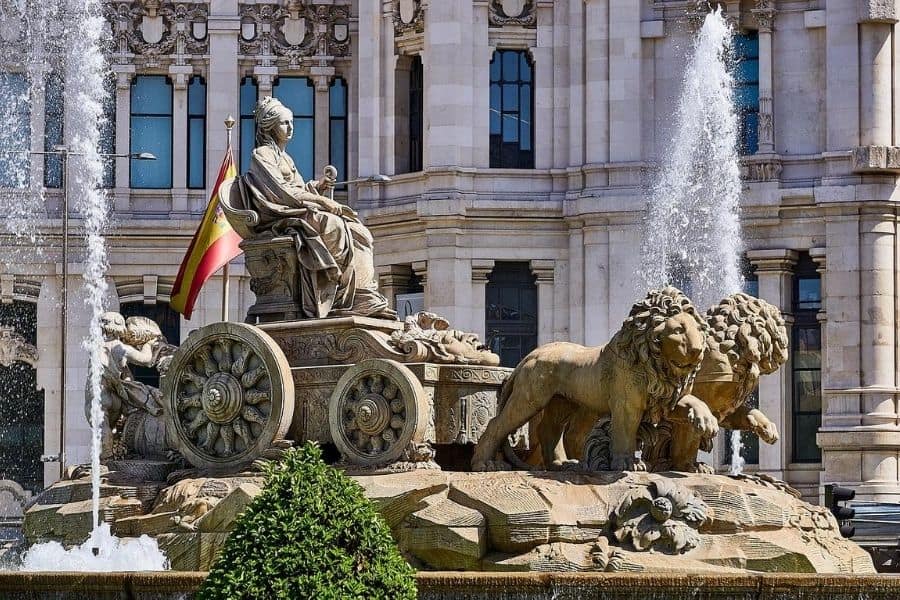
Though I do love taking free walking tours for general information about a city I’m visiting, there are often tours available with specific content or perspective that are interesting as well. History lovers may enjoy these tours as well if time permits.
Siesta
After your walking tour, take a break and grab lunch then consider heading back to your room for a siesta. This is a tradition in Spain, and you will find many shops and some restaurants close between 2 and 5 in the afternoon (or hours in between) for a rest. Whether you nap or just chill with a book, it’ll be late nights when you’re in Madrid!
It might seem counter-intuitive to suggest, well, a nap, when you’re on a tight timeline. 3 days in Madrid is definitely a bit tight. But, if you want to really connect with the culture, a siesta is a great way to understand the locals and to get on their timetable. There’s a reason they eat dinner so late and stay up late as well!
Or, you can tuck yourself into a quaint little place that you find open, like a cafe or a bodega. Enjoy a great cup of coffee or a sangria, a tasty red wine with spirits and fruit juices to rest for a little while. Because you’re in Spain, of course.
Reina Sofia Museum (Museo Nacional Centro de Arte Reina Sofía)
Next, visit the second-most famous museum in Madrid, the Reina Sofia Museum. Though the Prado is the bigger attraction, it gets quite busy, so you are best going when it opens in the morning. Also called El Reina, this museum is the Spanish national museum of 20th-century art.
It was named for Spanish Queen Sofia and opened in 1992. the museum is dedicated to Spanish art only and has impressive collections from the greatest Spanish artists of the 20th century, Pablo Picasso and Salvador Dalí.
It is probably best known for its most epic work that shows the harsh realities of modern war, Pablo Picasso’s Guernica. It’s a dark and moving painting and is regarded as one of the most powerful anti-war paintings in history.
It was painted in 1937 in response to the horrific bombing by Nazi Germany approved by the Fascist Spanish dictator, Francisco Franco. This incident is considered a prelude to World War II and the painting put a human face to the violence of the incident.
Millions visit this museum annually, and it is included in the top ten most visited art museums in the world. If you are a lover of more modern and post-modern art styles, this will be the museum for you.
The Reina Sofia Museum is located at Calle de Santa Isabel, 52, 28012 Madrid, Spain just a few minutes walk from the Prado. It is open on Monday and Wednesday through Saturday from 10 to 9. On Sunday, it is open from 10 to 2:30 and it is closed on Tuesday. It costs € 12 to visit (around $13 USD). Free admission is offered from 7 to 9 on Monday and from Wednesday through Saturday. Also, from 12:30 to 2:30 on Sunday.
Dine in Plaza Mayor
The many squares, or plazas, in Madrid are pretty incredible and they are worth your time to explore. Two of the most popular and famous ones are Plaza Mayor and Puerta del Sol.
Madrid has many great plazas to explore and Plaza Mayor is the one to go to for dining (as well as shopping). In fact, it’s lined with restaurants and you really can’t go wrong with them! It’s large, stately, and pedestrian-only so no dodging cars to walk around. And there is great entertainment available to watch, day and night.
This large plaza was once the center of Old Madrid, and it remains in the heart of the city. It was first built in the 1500s and was the main market in the city.
Plaza Mayor has gone by many names during its history, first “Plaza del Arrabal,” then “Plaza de la Constitución”, “Plaza Real”, “Plaza de la República” and now “Plaza Mayor.”
In addition to name changes, the plaza itself has also changed. It has burned down partially or completely three times in the 1600s and 1700s and was last rebuilt in 1854.
Today it is rectangular in shape and is closed off between the buildings except for 10 entrances. The buildings are all also uniformly three stories high. In the center of the plaza is a statue of King Philip III on a horse, placed in 1848. This plaza has hosted many events.
Originally, it included executions but it moved on to host bullfights, soccer games, and now the annual Christmas market. It’s quintessential Madrid and someplace you should definitely go at least for dinner.
Plaza Mayor is located in the center of Madrid here.
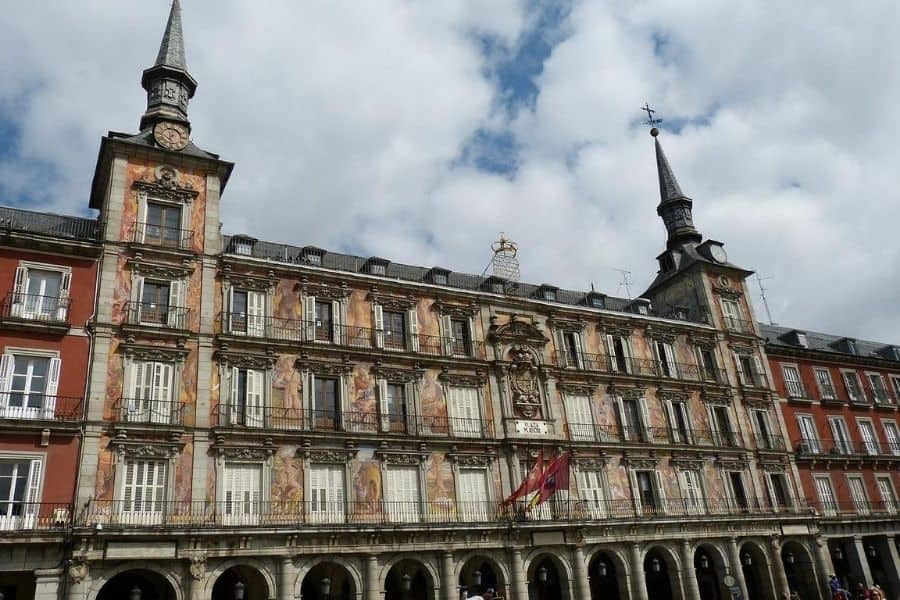
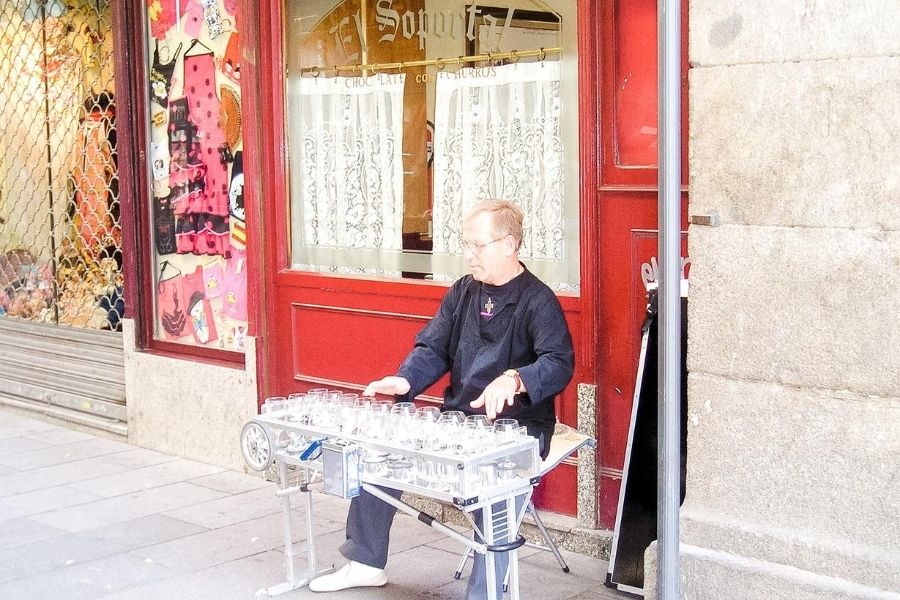
3 Days in Madrid: Day 2
Day 2 of your 3 days in Madrid is all about royalty, from a visit to the exquisite Royal Palace to a stroll in the royal garden, El Retiro.
Royal Palace (Palacio Real)
The Royal Palace of Madrid is a massive masterpiece and is the largest in Europe at 1.45 million square feet (135,000 square meters). It has an astounding 3,400 rooms. It’s the official residence of the Spanish royal family, though it’s used for ceremonial occasions.
It was built by King Phillip V in the 1700s. He was born in Versailles and this was designed to be his “Versailles.”
The Palace is located on the site of a 9th-century Moorish Alcázar (a castle or palace) in western Madrid. The original Castillian palace was built in the 16th century, however, it burned down in 1734.
A new palace was built on the same site and it was completed in 1755. An interesting fact—the palace was inspired by sketches Bernini made for the Louvre Museum in Paris as well as Versailles.
Like all of the royal palaces of Europe, the Madrid Royal Palace is known for its opulence. This includes paintings from many famous Spanish painters like Francisco de Goya, the world’s only complete Stradivarius string quartet, and an extensive Royal Armory.
You’ll see a lot of gold leaf throughout the palace and incredibly ornate items.
The Royal Palace is located at Calle de Bailén, s/n, 28071 Madrid, Spain. It’s open Monday to Saturday from 10 to 7 (in the winter from 10 to 6) and on Sunday from 10 to 4 and costs 20€ ($21 USD). Free entry is offered as of this writing from Monday to Thursday from 5 to 7 (4 to 6 in the winter).
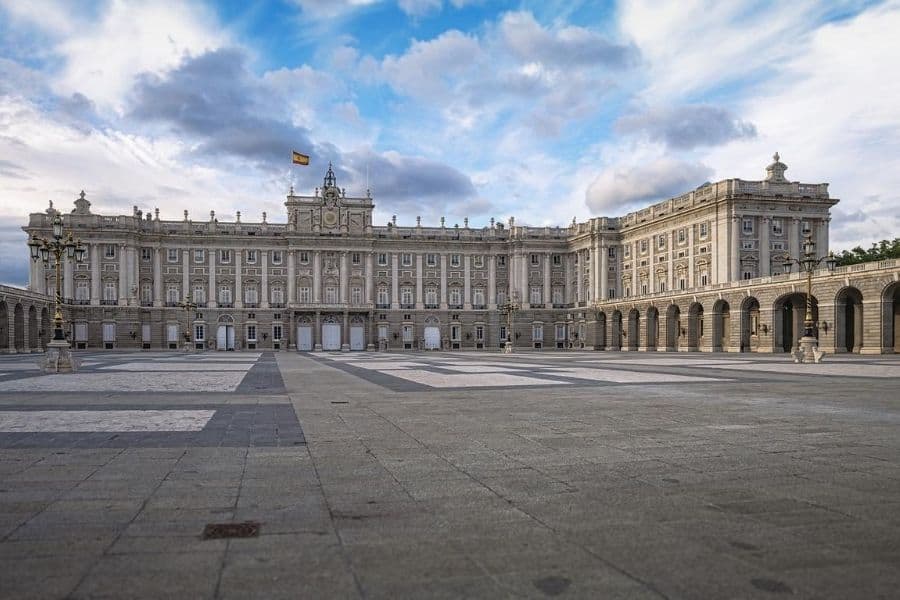
Walk Around Retiro Park (Parque del Buen Retiro)
The Buen Retiro Park, meaning “Park of the Pleasant Retreat” is simply magnificent. Calling this a park seems to somehow undermine how incredible it truly is.
El Retiro, as it’s often called, is just a massive masterpiece. It has a large and peaceful lake, lovely gardens, sculptures, monuments, and more. Many of Madrid’s events are held at El Retiro as well.
The park was founded around 1505 by Queen Isabella I. A church and monastery were built on the land, and the royal family built the Church for a retreat of their own.
When the Spanish court moved to Madrid in the mid-1500s, the park was enlarged. Gardens were further expanded in the early 1600s.
Some other features of Retiro Park include:
- The Crystal Palace (Palacio de Cristal), is a glass pavilion filled with many interesting plants and flowers indigenous to the region.
- A rose garden (rosaleda) with a magnificent statue called Fountain of the Fallen Angel.
- Remains of Buen Retiro Palace are filled with an art collection.
- A Statue Walk (Paseo de las Estatuas) includes statues of the Spanish kings sculpted in the mid-1700s from the Royal Palace.
You can easily spend hours wandering this park and exploring the different sights within it. Even if you’re short on time in Madrid, I highly recommend this be part of your itinerary.
Retiro Park is located at Plaza de la Independencia, 7, 28001 Madrid, Spain.
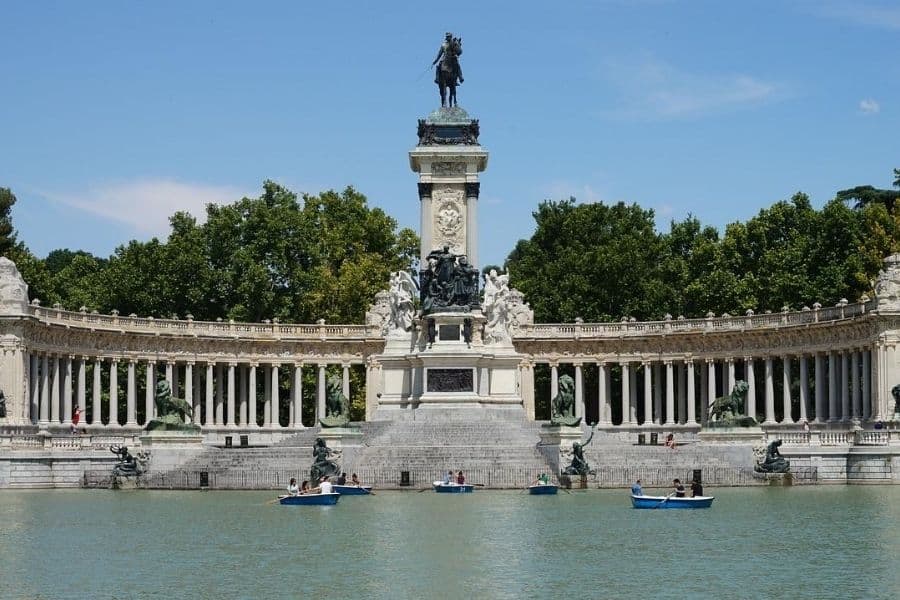
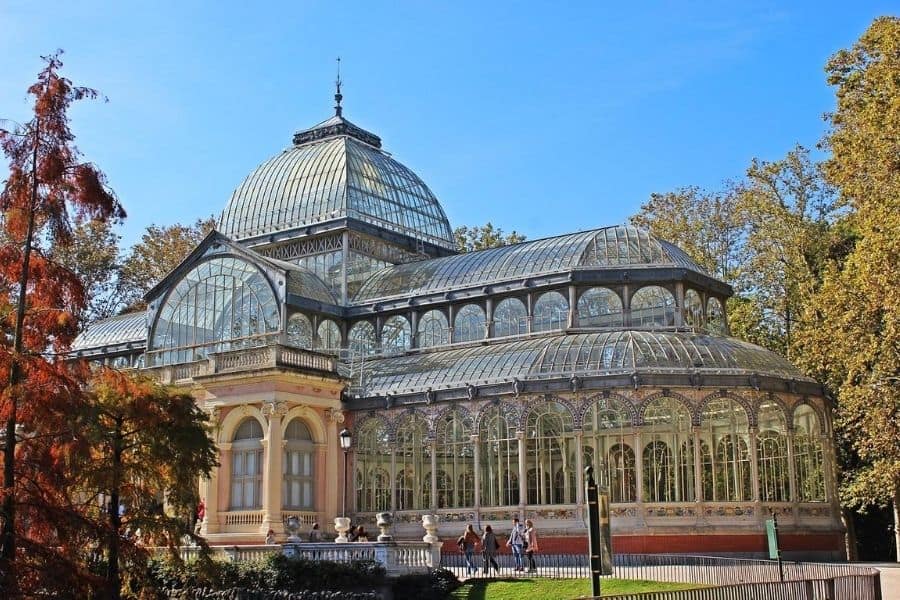
Flamenco
Ahhh… flamenco. Flamenco is a style of music with roots in southern Spanish folklore. It is typically music, song, and dance, and a beautiful art form known as uniquely Spanish that is enjoyed around the world. Flamenco is believed to have originated in Andalusia, Spain, and dates back to at least the mid-1700s.
Traditional flamenco features a guitar, a female dancer wearing a long, flowing dress, and a singer (who may be the dancer or the guitarist). It can be adapted to include two women dancing, a woman and a man, other musical instruments, and more.
There is something so quintessentially Spanish about watching flamenco. It has a flair for drama and is like watching an amazing soap opera on the stage. The dancer is also like an actor demonstrating high levels of passion and emotion.
Flamenco is usually shown late at night, and showings are often at ten and even midnight. So, go to your room to take a nap if you must, but definitely see it when you’re in Spain.
Seville may be the home of an originator of flamenco but it’s alive and well in Madrid. There are some tourist-type places to go, and there are some smaller local places as well. Either way, you’ll be impressed with the show of emotion, volatility, and talent.
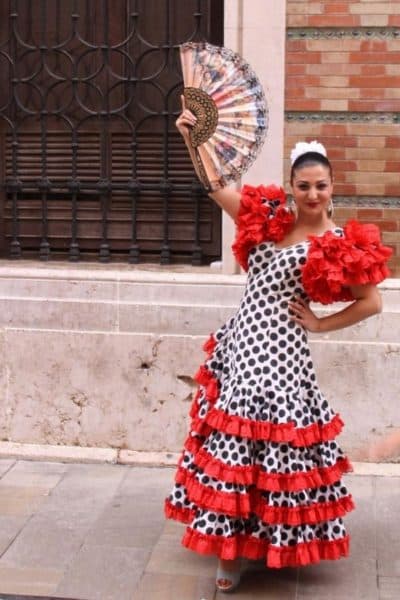
3 Days in Madrid: Day 3
Day 3 of your 3 days in Madrid tour is a focus on the museums and culture of Madrid, starting with a visit to Madrid’s (and Spain’s!) most famous museum, the Prado.
Prado Museum (Museo Nacional del Prado)
The Prado Museum is the main national art museum in Spain. The Prado, along with the Reina Sofia Museum and the Thyssen-Bornemisza Museum, make up the “Golden Triangle of Art” in Madrid.
This museum has one of the largest art collections in the world and one of the finest collections of European art. If you’re wondering if it’s worth it, visiting the Prado is the second top thing to do in Madrid, according to TripAdvisor. Millions visit every year, and it’s one of the most visited museums in the entire world.
The building is monumental and was constructed to be a grandiose and impressive building. And it’s packed full of incredible pieces of art. The museum owns over 5,000 pieces of art, though it loans out almost 2/3 of that to other museums. It is one of the largest museums in Spain, and millions of people visit it every year.
The Prado Museum is located at Calle de Ruiz de Alarcón, 23, 28014 Madrid, Spain. The National Botanical Garden is right next to the Prado, and the famous Retiro Park is just a few blocks away. It is open daily from 10 to 8 except for on Sunday when it is open from 10 to 7. It costs 15 Euros ($16 USD).
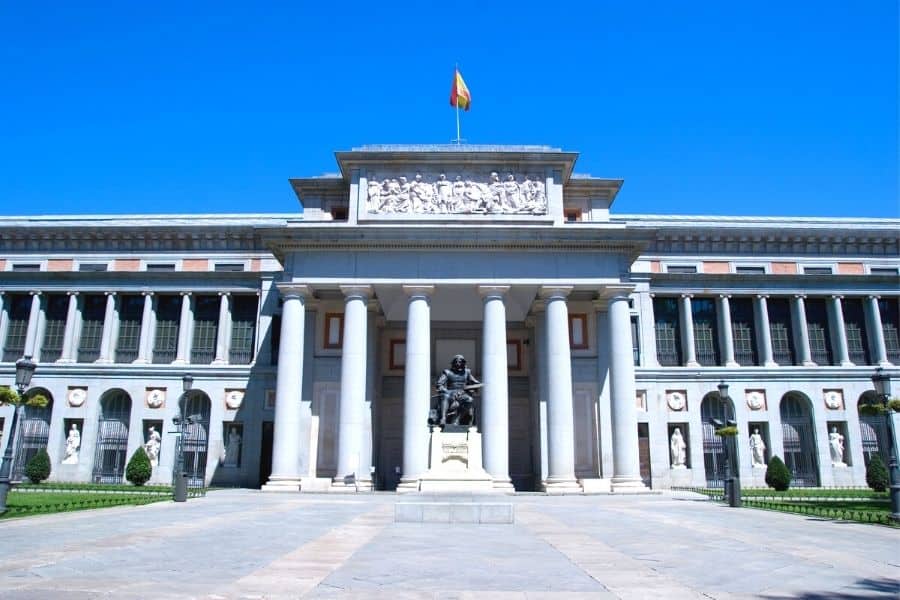
National Archaeological Museum (Museo Arqueológico Nacional)
If history is more your thing, then the National Archaeological Museum will be the place for you. It was established in 1867 and has an extensive collection from the Iberian Peninsula dating back before recorded history. It also has collections from Greece, Egypt, and smaller collections from some other areas as well.
The National Archaeological Museum is located at Calle de Serrano, 13, 28001 Madrid, Spain. Admission is only € 3 (around $3.50 USD). It is open from Tuesday to Saturday from 9:30 to 8, and on Sunday from 9:30 to 3. The museum is closed on Tuesdays.
Explore Puerta del Sol
Puerta del Sol is one of the best-known and busiest places in all of Madrid. It is the central point of a network of roads leading off of it, and it’s only a few blocks from Plaza Mayor.
This plaza included one of the original gates of the old city wall that surrounded Madrid in the 15th century. It faced east, thus the name for this square. It was historically an important meeting place.
This square is where the annual New Year’s Eve festivities in Madrid take place, with live broadcasts on tv since 1962. Puerta del Sol has a famous clock, and its bell marks the new year with the Twelve Grapes tradition, where people eat one grape with each toll of the bell to celebrate the beginning of a new year.
Additionally, there is also a statue in the center of King Charles III on horseback. The old Post Office is also in this plaza, which serves as the office of the President of Madrid.
Puerto del Sol is located here in the heart of Madrid.
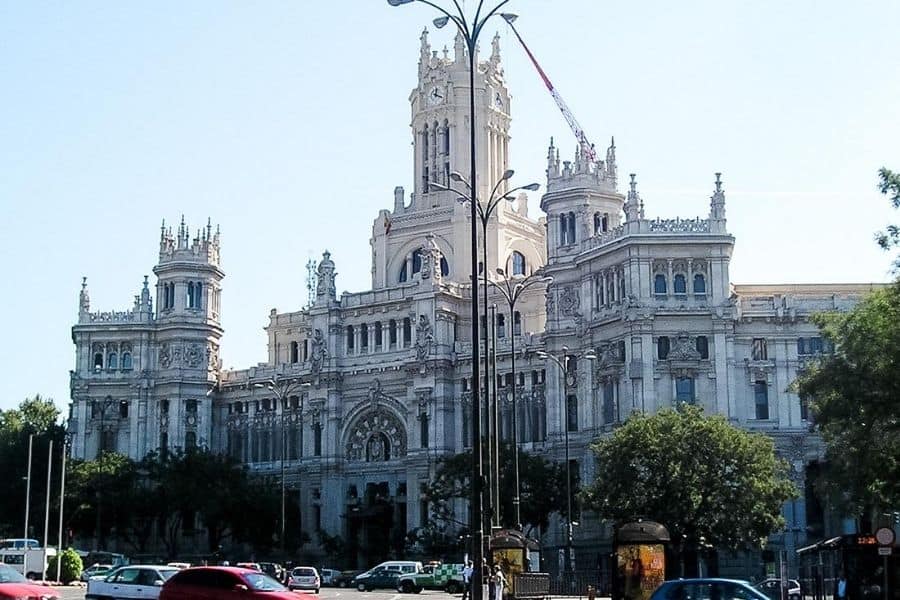
Must-Do Madrid
3 days in Madrid or less would not be fulfilled without trying tapas. I mentioned them earlier and now want to expand upon them. There are a couple of things you really should consider doing when you visit Madrid, or anywhere in Spain, for that matter.
I would go so far as to say that it wouldn’t be a visit to Spain if you don’t! Here they are and why I think they are so important.
Eat Tapas, Tapas, and More Tapas
Tapas are an important part of Spanish cuisine, and they are part of the culture in Spain. People traditionally enjoy a siesta from around 12 to 2, then return to work for a few hours. Once done, they often get tapas, small appetizers, or snacks made for sharing in the late afternoon.
There are tapas bars everywhere, and you can get tapas at many restaurants as well. You’ll often see trays and trays sitting near the front glass windows of places so you can see what they offer. Generally, there are many selections to choose from.
Tapas may be cold or hot. They may be as simple as jamón y queso (ham and cheese. And don’t scoff at “ham and cheese” as it is incredibly tasty!) or olives. Or they can be more sophisticated, like chorizo-stuffed dates, garlic shrimp, and grilled lamb.
People tend to enjoy tapas on the run, eating one in a place and then moving between bars doing the “tapa tango.” Stab something interesting with a toothpick, a common way to eat many tapas. Keep ordering until you’re done, and pay when you go.
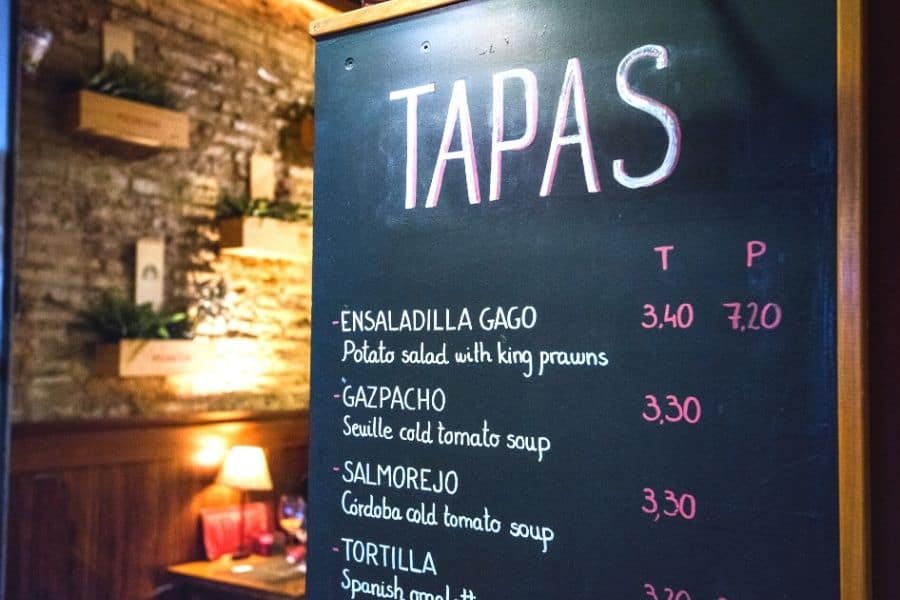
Try Jamón Iberico
Ham, or jamón, is a big deal in Spain. It is a cured ham, similar to prosciutto in Italy (though don’t let any Spaniards hear you say that!) Jamón Iberico is the premium type, and it’s worth trying to see the difference.
You’ll pay for it, and where you can get a jamón dish for a few Euros, Jamón Iberico will run you more like ten to twelve. It’s a difference you can taste, though, and it’s worth trying.
You can get it at tapas bars, restaurants, and snack shops. They have shops offering different kinds of cured hams that you can try in these paper wrappers. Grab one on the go and wander Madrid while enjoying this tasty snack.

Dinner in Madrid
Dinner is generally eaten quite late by much of the world’s standards, at nine or ten at night. I personally don’t love eating dinner at ten at night as it’s just too late, and I wake feeling really bloated. So, I was quite happy to make a dinner of tapas every night!
Tapas are made for sharing, so you can get a number of great dishes to try if you’re traveling with someone. One word of caution: the shrimp often come whole, and I mean head-on whole. They are incredibly tasty, though, if you can get past that. (Yes, I covered them with a napkin! haha!)
So, do eat a proper dinner if it works for you. But if not, know there are tapas to the rescue!
Chocolate con Churros (Chocolate with Churros)
If you are a chocolate lover, then this is the thing for you! Chocolate is a hot cup of hot chocolate, but that doesn’t entirely describe it.
It’s thick, and if you were to mix hot cocoa with a warm chocolate pudding, that’s what it is like. It’s rich, creamy, and oh-so-good. I joked that the spoon could stand up in the cup, and it almost did!
The best way to eat chocolate is with warm churros. A long, round pastry covered in cinnamon. I’m almost drooling thinking of it! So, save some room from tapas and consider a dessert of chocolate con churros.
Where to Stay in Madrid
When visiting Madrid, I recommend staying in the historic center as it’s where you will likely spend most of your visit. It saves you travel time, and though it is a bit expensive, there are reasonable options.
High End
The Principle Madrid is exquisite luxury at its finest. It’s a boutique hotel located in a prime location close to all of the downtown attractions. Rooms have every comfort, and one of the top appeals of this hotel is the expansive roof deck with incredible views. The Principle Madrid is located at Calle del Marqués de Valdeiglesias, 1, 28004 Madrid, Spain.
Mid-Range
B&B Hotel Madrid Centro Plaza Mayor is a great mid-range hotel just steps from Plaza Mayor. It’s in a great location and easy to get around, and of course, its proximity to Plaza Mayor makes it a great location for dinnertime!
My friend and I actually stayed here a number of years ago and enjoyed it. The service was wonderful, and the reviews are still positive. This property is located at Calle de Atocha, 2, 28012 Madrid, Spain.
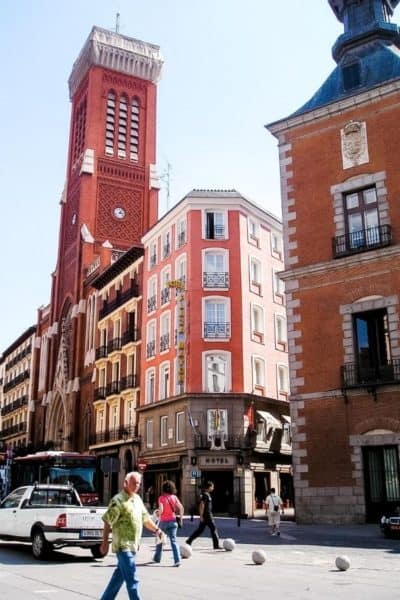
Budget
Hostal Madrid Centro is an incredible value right in the heart of Madrid. It offers dorm-style rooms for a tight budget as well as private rooms with private bathrooms. It is located at Carrera de S. Jerónimo, 32, 28014 Madrid, Spain.
Where to Eat in Madrid
When I visited Madrid, we ended up eating tapas for dinner every night in and around Plaza Mayor. We actually didn’t even look for recommendations and found that every place was just incredible.
You pay more in a tourist area like Plaza Mayor, but you’re more likely to get a great meal. Places won’t stay in business long there if no one goes!
Some of the top tapas bars in the Centro area:
- Tinto y Tapas, Calle de Almadén, 14, 28014 Madrid, Spain.
- El Sur, Calle de la Torrecilla del Leal, 12, 28012 Madrid, Spain.
- Bodega de la Ardosa, Calle de Colón, 13, 28004 Madrid, Spain.
- Taberna la Concha, Calle de la Cava Baja, 7, 28005 Madrid, Spain.
Some of the top restaurants serving local fare:
- Fiaschetteria La Saletta, Calle de Santa Isabel, 5, 2nd floor, 28012 Madrid, Spain.
- Astor, Calle del Almendro, 9, 28005 Madrid, Spain.
- Restaurant DCorazon, Plaza Mayor, 30, 28012 Madrid, Spain.
And for an interesting treat and to learn all about the local favorite, jamon, is the Museo de Jamon (Museum of Ham). It’s recommended by Rick Steeves, so it’s got to be good! There are a number of locations around Madrid.
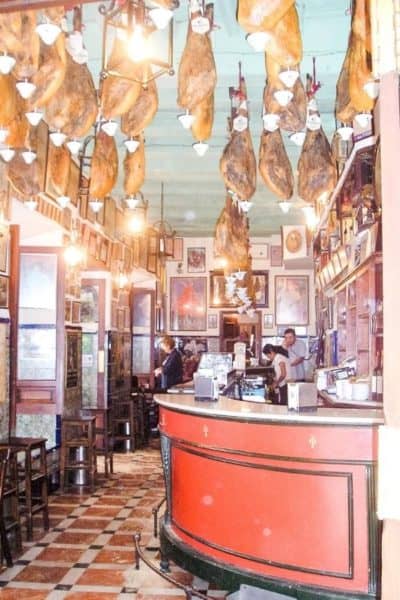
Madrid Airport
The Madrid airport (MAD) is very large, and it’s the country’s busiest airport and Europe’s sixth busiest. The full name: Adolfo Suárez Madrid–Barajas Airport, in Spanish: Aeropuerto Adolfo Suárez Madrid-Barajas. Madrid-Barajas Airport opened in 1928 and is 8 miles (13 km) from the city’s historic center.
It’s very convenient to get to the historic center from the airport, as the Metro runs directly to it (Barajas stop). This airport is a hub for Iberia and Air Europa and a common international connection point.
I have spent many vacations traveling through (and running through!) this airport. There are five terminals, and it’s actually the second largest airport in Europe in terms of size, behind the Paris Charles de Gaulle Airport. The airport is modern, and I have found it to be very easy to navigate.
To get to the city center from the airport, there are four options: taxi, train, Metro, and bus. A taxi will run you around 30€ (around $32.25 USD), and it’s the most convenient way to go. The train costs 2.6€ each way (around $2.80 USD) and will take just under 30 minutes.
The Metro costs 3€ (around $3.50 USD) one-way and takes a little over 20 minutes. The bus takes the longest and costs 5€ ($5.90 USD).
How to Get Around Madrid
The historic center of Madrid is a great walking area—walking is a popular way to navigate it. It’s much faster getting around than taking taxis, though, of course, that is an option. There is also a very good subway system, the Metro. It’s affordable, safe, and clean.
The Metro has over 300 stations, so even if you want to go to the suburbs, it’s got you covered! It runs every 2 minutes during rush hour and every 15 minutes during off-peak times. The Metro runs from 6:30 a.m. to 1:30 p.m.
The Metro map can be found here, and the link to the bus map is there as well. The link to the most current Metro costs is here. To use the Metro, purchase a Tarjeta Multi-card for 2.50€ at any Metro station from the ticket machines with a red sticker that says, “Tarjeta MULTI Disponible AQUI.”
You can also get them from tobacco shops (Estancos). If you purchase the Tourist Travel Pass for 1, 2, 3, 5, or 7 days, it is free. You can then load additional rides on the card, either single or a pack of ten.
Madrid Weather and the Best Time to Go
The spring and fall are the best times to visit Madrid, from March to May and September to November. If you are going to spend 3 days in Madrid, it’s the time of year I recommend. The temperatures are great for walking around the city and not too hot.
The summer is peak tourist season though it’s quite hot, and many of the shops close during this time of year to go on vacation. Winter is the cheapest time to go, and many of the hotels do reduce their rates.
Average temperatures range from a low of 36°F and a high of 88°F (2.22°C to 31.11°C). The temperature rarely goes below 23°F or higher than 99°F (-5°C to 37.22°C). Summers are short, hot, and dry and the winters in Madrid are cold and partly cloudy.
January is the coldest month of the year, and while Madrid isn’t known for getting much snow, January will see it occasionally. Rain is most likely in April and May, though it is sometimes found outside of the summer months.
Plan for at least three full days to visit if you can, though four or five days is really the sweet spot for this city.
Best Places to Visit Near Madrid
There are a lot of great options for day or weekend trips to visit near Madrid. Two of the most popular places to go include Toledo and Córdoba.
Toledo
If you find you have some extra time in Madrid, it’s a great idea to consider a day trip. The place I visited was the historic and beautiful city of Toledo. When I went, I had just finished around ten days in Madrid, Córdoba, and Seville.
In truth, I was exhausted and tried to push through for one more place to visit. I didn’t plan, had no clue where to go, and just wandered the streets. Even that was pretty amazing, and it is really beautiful.
There are a lot of things to see and do in Toledo and it’s worthy of a couple of days at least in its own right. But it’s also a wonderful day trip and worth a visit. It has a stunning Cathedral and Alcázar to start with.
And the city is built on the top of a large hill, offering some truly stunning views. The train (Renfe) takes just over 30 minutes, and costs vary but are around $15 USD each way.
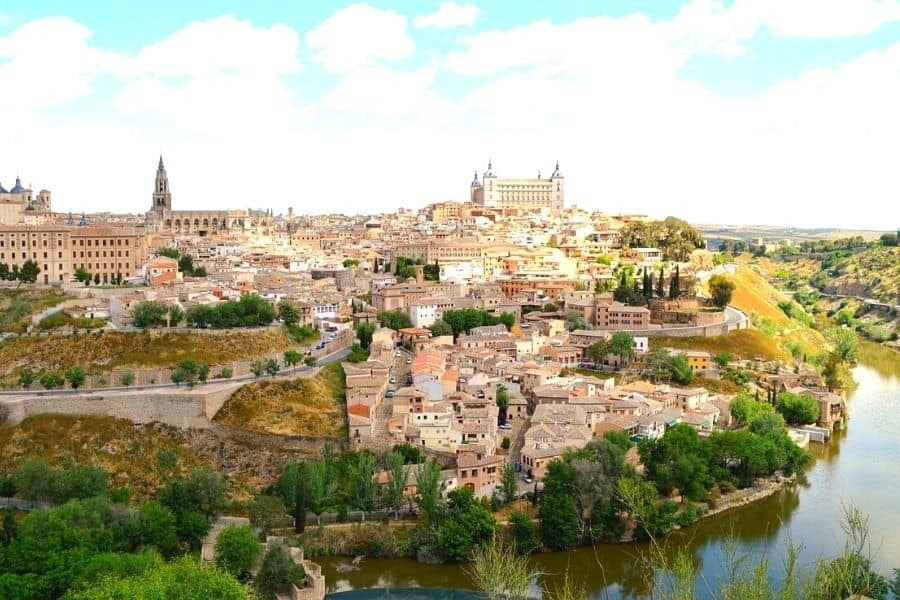
Córdoba
Córdoba is located between Madrid and Seville. It takes around 2 hours from Madrid on the high-speed train. This makes it a great day trip; though I loved this city so much, I’d highly recommend at least a couple of days there.
You May Also Like Top Things to do in Córdoba in One Day
Or, you can take a train from Madrid to Córdoba and end your evening in Seville, which is what I did. I loved it and wished I had an extra day or two to explore, as there is so much to see and do.
Córdoba is a city that successfully blended Christian, Jewish, and Muslim cultures for hundreds of years. The architecture reflects it, and it hosts some of the most exquisite buildings I have ever seen. And for an architecture lover, that’s saying something!
If you have the opportunity to—go. You won’t regret it!
A Brief History of Madrid
If you’re interested in a little more about the history and current Madrid, let’s walk through that now!
The Madrid area has been occupied since prehistoric times. There is evidence of Visigoth (Germanic tribes) and Roman settlements and documented evidence of a settlement in the latter part of the 9th century during the Muslim Age.
At that time, the ruler of the country resided in Córdoba and he built a fortress near the Manzanares River. It was built to protect the region from Christian invasion.
Madrid ended up falling to the Christians in 1085 and became part of the kingdom of Castile. In 1188, Madrid officially became a city and established a government system thirty years later. The city continued to grow in population and influence and in 1606, Madrid became the capital of Spain.
Modern-Day Madrid
Madrid is the capital of Spain and it’s nestled in the center of the country. It’s the second-largest city in Europe with over 6.5 million people in Madrid and the metropolitan area.
It is a thoroughly modern city with its infrastructure but has worked to maintain the look and feel of the city through its historic neighborhoods and important architecture like Plaza Mayor, the Royal Palace, and the Royal Theater, among others.
It now is a large urban sprawl that surrounds a largely intact historical center. This area is very walkable and easy to navigate. And yes, this says a lot coming from me, the queen of getting lost! While 3 days in Madrid doesn’t seem like a lot, you can certainly do quite a bit.
This central area is flocked by the Royal Palace and the Prado Museum in the west and east, and in the center of the two, the most notable squares, Plaza Mayor and Puerta del Sol.
Don’t Miss 3 Days in Madrid
It’s always fun to re-live some of my trips. I went to Madrid many years ago, and it’s amazing to me how vivid my memories are.
Madrid really stands out in my mind, and that’s a testament to what an incredible place it is. 3 days in Madrid is not nearly enough, but if you make the most of your time, you can get a great view of this city’s highlights and a strong temptation to return.
You Might Also Like
- The Most Beautiful Cities in Spain
- What to Do on a Barcelona Weekend
- 11 Top Things to Do in Seville You Can’t Miss
- Top Things to do in Córdoba in One Day
- Best Day Trip from Barcelona to Montserrat
- One Day in Madrid: Top Things to See and Do
Like it? Pin it!
